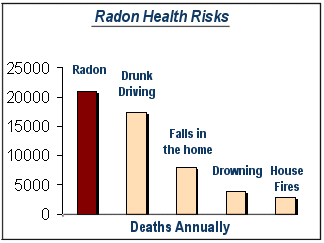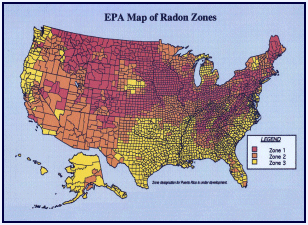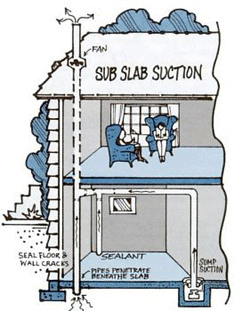Florida Radon Facts
Radon is a naturally occurring, Cancer Causing, Radioactive Gas that results from the decay of Radium in the Earth's crust and is very common in Florida.
You can't see radon. You can't smell or taste radon. But radon gas could be a problem in your home. Fact is, radon kills about 21,000 Americans every year according to the EPA. That's more deaths than drunk drivers, house fires or even drownings and falls in the home combined. Radon in your home is definitely something you need to be concerned about, because when you breathe air containing radon, you can get lung cancer. In fact, the Surgeon General has warned that radon is the second leading cause of lung cancer in the United States. Only smoking causes more lung cancer deaths. If you smoke and your home has high radon levels, your risk of lung cancer is especially high.
Fortunately you can test for Radon, and even if you find high levels it is usually easily treatable to bring Radon Gas down to an acceptable level.
If You are Selling a Home...
The EPA recommends that you test your home before putting it on the market and, if necessary, lower your radon levels. Save the test results and all information you have about steps that were taken to fix any problems. This could be a positive selling point.
If You are Buying a Home...
The EPA recommends that you know what the indoor radon level is in any home you are considering buying. Ask the seller for their radon test results. If the home has a radon-reduction system, ask the seller for information they have about the system. If the home has not yet been tested, you should have the house tested.
If you are having a new home built, there are features that can be incorporated into your home during construction to reduce radon levels.
These radon testing guidelines have been developed specifically to deal with the time-sensitive nature of home purchases and sales, and the potential for radon device interference. These guidelines are slightly different from the guidelines in other EPA publications which provide radon testing and reduction information for non-real estate situations.
|
Short Term Testing Options |
What To Do Next |
|
Passive: Take two short-term tests at the same time in the same location for at least 48 hours. or Take an initial short-term test for at least 48 hours. Immediately upon completing the first test, do a second test using an identical device in the same location as the first test. |
Fix the home if the average of the two tests is 4 pCi/L or more. |
|
Active: Test the home with a continuous monitor for at least 48 hours. |
Fix the home if the average radon level is 4 pCi/L or more. |
This guide recommends three short-term testing options for real estate transactions. The EPA also recommends testing a home in the lowest level which is currently suitable for occupancy, since a buyer may choose to live in a lower area of the home than that used by the seller.
Any home can have a radon problem, including new and old homes, well-sealed and drafty homes, and homes with or without basements. In fact, you and your family are most likely to get your greatest radiation exposure at home. That is where you spend most of your time.
Nearly one out of every 15 homes in the United States is estimated to have an elevated radon level (4 pCi/L or more). Elevated levels of radon gas have been found in homes in your state.
The average indoor radon level is estimated to be about 1.3 pCi/L; roughly 0.4 pCi/L of radon is normally found in the outside air. The U.S. Congress has set a long-term goal that indoor radon levels be no more than outdoor levels. While this goal is not yet technologically achievable for all homes, radon levels in many homes can be reduced to 2 pCi/L or below.
As with other environmental pollutants, there is some uncertainty about the magnitude of radon health risks. However, we know more about radon risks than risks from most other cancer-causing substances. This is because estimates of radon risks are based on data from human studies on underground miners. Additional studies on more typical populations are underway.
Your radon measurement will give you an idea of your risk of getting lung cancer from radon. Your chances of getting lung cancer from radon depend mostly on:
- tour home's radon level;
- the amount of time you spend in your home; and
- whether you are a smoker or have ever smoked.
Smoking combined with radon is an especially serious health risk. If you smoke or are a former smoker, the presence of radon greatly increases your risk of lung cancer. If you stop smoking now and lower the radon level in your house, you will reduce your lung cancer risk.
Based on information contained in the National Academy of Sciences' 1998 report, The Health Effects of Exposure to Indoor Radon, your radon risk may be somewhat higher than shown, especially if you have never smoked. It's never too late to reduce your risk to lung cancer. Don't wait to test and fix a radon problem. If you are a smoker, stop smoking.
What should I do if the radon level is high?
The EPA recommends that you take action to reduce your home's indoor radon levels if your radon test result is 4 pCi/L or higher. It is better to correct a radon problem before placing your home on the market because then you will have more time to address a radon problem.
If elevated levels are found during the real estate transaction, the buyer and seller should discuss the timing and costs of the radon reduction. The cost of making repairs to reduce radon levels depends on how your home was built and other factors. Most homes can be fixed for about the same cost as other common home repairs, such as painting or having a new hot water heater installed. The average cost for a contractor to lower radon levels in a home can range from $800 to about $2,500.
How To Lower The Radon Level In Your Home
A variety of methods can be used to reduce radon in homes. Sealing cracks and other openings in the foundation is a basic part of most approaches to radon reduction. The EPA does not recommend the use of sealing alone to limit radon entry. Sealing alone has not been shown to lower radon levels significantly or consistently.
In most cases, a system with a vent pipe and fan is used to reduce radon. These "sub-slab depressurization" systems do not require major changes to your home. Similar systems can also be installed in homes with crawlspaces. These systems prevent radon gas from entering the home from below the concrete floor and from outside the foundation. Radon mitigation contractors may use other methods that may also work in your home. The right system depends on the design of your home and other factors.
As you can see, knowing the Radon levels in your home is very important so don't forget to ask for a Radon Screening when you schedule your home inspection -- You'll be glad you did.
We hope you found this article informative and look forward to serving your inspection needs.
Respectfully, Al Napier - CPI, IAC2 Vanguard Home Inspection